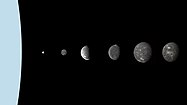Wikipedia:Today's featured list/December 20, 2021
Uranus, the seventh planet of the Solar System, has 27 known moons, most of which are named after characters that appear in, or are mentioned in, the works of William Shakespeare and Alexander Pope. Uranus's moons are divided into three groups: thirteen inner moons, five major moons, and nine irregular moons. The inner and major moons all have prograde orbits, while orbits of the irregulars are mostly retrograde. The inner moons are small dark bodies that share common properties and origins with Uranus's rings. The five major moons are ellipsoidal, indicating that they reached hydrostatic equilibrium at some point in their past (and may still be in equilibrium), and four of them show signs of internally driven processes such as canyon formation and volcanism on their surfaces. William Herschel discovered the first two moons, Titania and Oberon, in 1787. The other three ellipsoidal moons were discovered in 1851 by William Lassell (Ariel and Umbriel) and in 1948 by Gerard Kuiper (Miranda). (Full list...)
